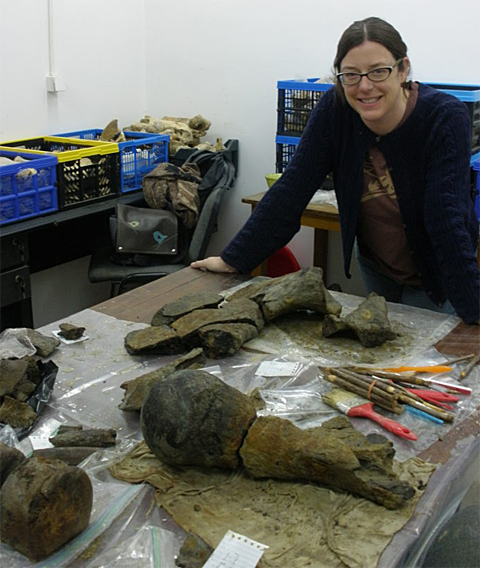
Dr. Sabrina Curran in lab at Institute of Speleology in Romania with the newly excavated partial mammoth skeleton
by Harlee Rozell ’17
Last summer Dr. Sabrina Curran, Assistant Professor of Anthropology, traveled to Romania to continue her research involving the geographical movement of the Homo erectus species, an ancestor of modern humans, during the early Pleistocene.
Her interest in this project began in 2008, when she first traveled to Romania to learn more about Pleistocene deer species in Eurasia.
Four years ago Curran began work in the Olteţ River Valley with an international team including Claire Terhune (University of Arkansas), Alexandru Petculescu and Marius Robu (Institute of Speleology, Romania), and Chris Robinson (Bronx Community College).
The team decided to continue their search at and around sites La Pietris and Grăunceanu and recently received funding from the National Science Foundation with a high-risk grant, meaning they were granted funds for a project that could potentially yield no results.
The sites within the river valley, an area roughly as large as Athens to Nelsonville, were excavated in the 1960s and resulted in the discovery of fossilized remains in the form of bed bones. However, because of the political atmosphere in Romania at the time, much of the provenience and other necessary information needed to locate the original sites has been lost.

Daisies and poppies in Romania, summer 2016.
What was the Environment in the Past?
“Our project is focused on finding the original sites from 1960s, while continuing to search for new exposures in the area,” Curran explains.
“My colleagues and also I wish to learn more about the environment of this location during the time our ancestors could have lived here. So far, little evidence has been found to support the presence of Homo erectus in the valley, but learning more about the environment and the species that did habitat the area could give us insight into the lives of our ancestors. That is our question: What was the environment?”
Field Methods
Curran continues her explanation by discussing some of the field methods utilized by her team.
“Our project is to go back to the river valley and do surveys; partially pedestrian and partly driving. In this area, the exposures we are searching for are from landslides, river cuts or areas where local agriculturalists have cut out the land in order to build fences or other structures. This river valley is actually very similar to Southeastern Ohio, with beautiful hillsides with steep inclines and large valleys, so we often have to hike through areas dense with flora and mud.”
Discoveries!
Dr. Sabrina Curran in lab at Institute of Speleology in Romania with the newly excavated partial mammoth skeleton
Their surveys and excavations have produced some striking discoveries, including the lower half of a mammoth, which they discovered in 2012.
“Part of its femur was eroded out, and the lower half of it was already eroded away,” Curran explains. “We were able to locate the top half of the femur including the femoral head, most of the pelvis and several lumbar and caudal (tail) vertebrae—all in situ and articulated positions. At that point, we had to stop.”
The fossil was wedged into the side of a steep hill, requiring digging further into the hillside, removing some trees at the top of the hill, and then digging down from the top of the hill.
With the funds granted by the NSF, the group will be able to return to Romania and continue their research in the summer of 2017, with the assistance of students from the University of Arkansas and OHIO Anthropology’s Samantha Gogol ’16.
Curran hopes that to finish excavating the mammoth skeleton and find even more exposures in order to help better describe the environment of the Olteţ River Valley during the Pleistocene.


















Comments